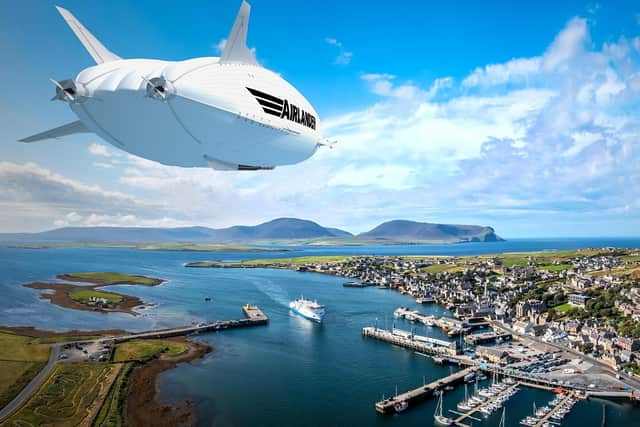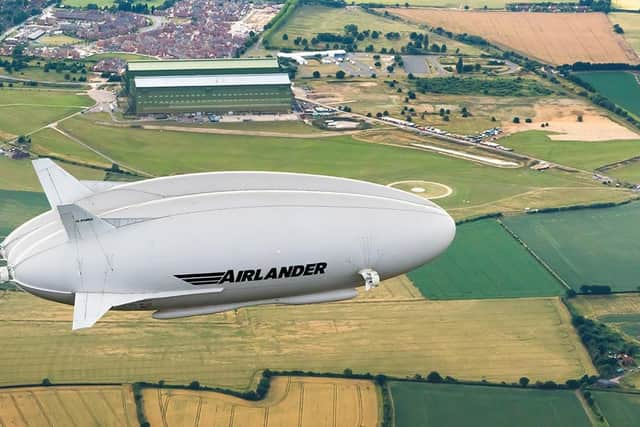Airlander 10: firm set to build giant airships in Yorkshire hails ‘phenomenal opportunity’ for region over next 30 years
Hybrid Air Vehicles last month agreed terms with City of Doncaster Council for a 50-hectare site to produce and test the Airlander 10, a helium-filled airship capable of carrying up to 100 passengers or a 10 tonne payload.
The aircraft is able to stay in flight for up to five days, and can land on grass, ice or water.
Advertisement
Hide AdAdvertisement
Hide AdAs well as a potential alternative to standard flight, plans for its use include luxury tourist experiences and the setting up of temporary communication networks over disaster zones.


Compared with aircrafts of a similar size, the Airlander 10 will offer an initial 75 per cent reduction in co2 emissions when run on standard kerosene-based fuel. The company has plans to increase this to a 90 per cent reduction by 2028, using two electric engines out of four, and a 100 per cent reduction by 2030, when the firm says all engines on the Airlander 10 will be electric.
Tom Grundy, CEO of Hybrid Air Vehicles, said: “As an aerospace industry, we’re going through what will be a really big transition. We’ve had many years of a one size fits all approach to aircraft design, but now we’ve got a different set of challenges, a different set of energy sources and fuel sources to use, to deliver all the benefits of aviation without the impact.
“For me, to be leading a project that is at the leading edge of solving those challenges, there is nowhere else more exciting to be.
Advertisement
Hide AdAdvertisement
Hide Ad“I would love everybody who's got kids across the region, and everyone who is in aviation and aerospace, to know we have this phenomenal opportunity, not just today, but over the next 20 to 30 years for great jobs working on that mission.”


Hybrid Air Vehicles has said the Doncaster facility will create around 1,200 jobs both directly and through the supply chain. The company currently expects the aircrafts to be produced with certification in around four years, with plans to build 24 Airlander 10s per year.
Hybrid Air Vehicles is the first firm since 1979 to submit a Type Certification application to the UK Civil Aviation Authority for a new style of aircraft.
Mr Grundy noted that the company hopes for prices for consumers to use the Airlander 10 to remain competitive with current transport methods.
Advertisement
Hide AdAdvertisement
Hide AdHe said: “In my view, this doesn't work if you set out to say ‘everything will be fine because people will pay a premium for low emissions’ – that's not what we’re all about here – this is about practical, economic, everyday options.
“End pricing is down to the airline, so we can't talk exact, but the point here is to deliver this new transport option within the range of prices that we already pay for transport.
“My job as a deliverer is to put something into the market that can operate economically and be affordable to the passenger, and that's what we’re doing.”
Hybrid Air Vehicles also has plans to construct two larger airships, titled the Airlander 50 and Airlander 200. A location for the production of these vehicles has not yet been decided.
Advertisement
Hide AdAdvertisement
Hide AdMr Grundy added: “These are big parts of our future. We’re at the start of the drive to achieve our goals here, and this is all about getting airlander 10 into the market, but from there, like other aircraft types, it's about growing.”
Speaking on safety for the Airlander 10, Mr Grudy said: “The level of safety and certification that is applied for us is exactly the same as other parts of aerospace. A lot of people look quite a long way into the past at airships, and particularly the Hindenburg, but I think what you saw there was 1930s technology, and you could look at 1930s aeroplanes now which wouldn’t look very much like what we see today either.
“We’re coming back to the market with something that is quite different to 1930s airships, and we’re coming back because the economic case is there now, and the recognition that we can't throw jet fuel at every problem, because we’ve got climate change to combat very fast.
“I think if we had been able to do that, economically between 1937 and now, then we wouldn't remember the Hindenburg in the way that we do, because we all remember the Titanic, but most of us would still get onboard a boat.”
Comment Guidelines
National World encourages reader discussion on our stories. User feedback, insights and back-and-forth exchanges add a rich layer of context to reporting. Please review our Community Guidelines before commenting.